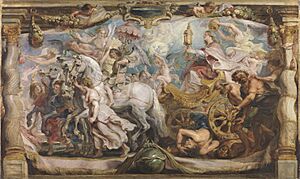The Triumph of the Church (Rubens) facts for kids
The Triumph of the Church is a famous painting by Peter Paul Rubens. It is also known as The Triumph of the Church over Fury, Discord and Hatred. Rubens painted it around 1625. This oil painting is now kept at the Museo del Prado in Madrid, Spain. It measures about 63.5 centimeters (25 inches) tall and 105 centimeters (41.3 inches) wide.
Contents
About the Painting Series
This painting is part of a larger group of artworks. These paintings celebrate the Eucharist, which is a special religious ceremony in the Catholic Church. They also show support for the Catholic faith and the Counter Reformation. The Counter-Reformation was a time when the Catholic Church worked to renew itself and respond to the Protestant Reformation.
From Paintings to Tapestries
Rubens first created these paintings as small models, called modelli. These models were used to design huge tapestries. Tapestries are thick, woven cloths with pictures. These large tapestries were meant to be shown during important religious events. One such event was Corpus Christi, a special feast day. They were displayed at the Convent of Las Descalzas Reales in Madrid.
Who Commissioned the Art?
The paintings were made between 1622 and 1625. They were ordered by Isabel Clara Eugenia. She was the daughter of Philip II of Spain. At the time, she was the governor of the Spanish Netherlands. This area was Rubens' home country. It also had famous factories in Brussels that made tapestries.
The actual tapestries were woven between 1627 and 1632. They were made in these factories and in the workshop of Jan II Raes. After they were finished, they were sent to the Spanish royal court. Rubens sometimes made small changes in his final drawings for the tapestries.
Other Paintings in the Series
The Triumph of the Church was one of the most important paintings in this series. The tapestry made from it was likely the largest. It also had the most complex design and meaning.
Other paintings in this series included:
- The Triumph of Divine Love
- The Meeting between Abraham and Melchizedek
- The Victory of Virtue over Heresy
- The Victory of the Eucharist over Idolatry
- The Defenders of the Eucharist
Most of these artworks used allegory. Allegory means using symbols and characters to represent ideas. They had strong messages supporting Catholic beliefs. Some also showed stories from the Old Testament of the Bible.
See also
 In Spanish: El triunfo de la Iglesia (Rubens) para niños
In Spanish: El triunfo de la Iglesia (Rubens) para niños


